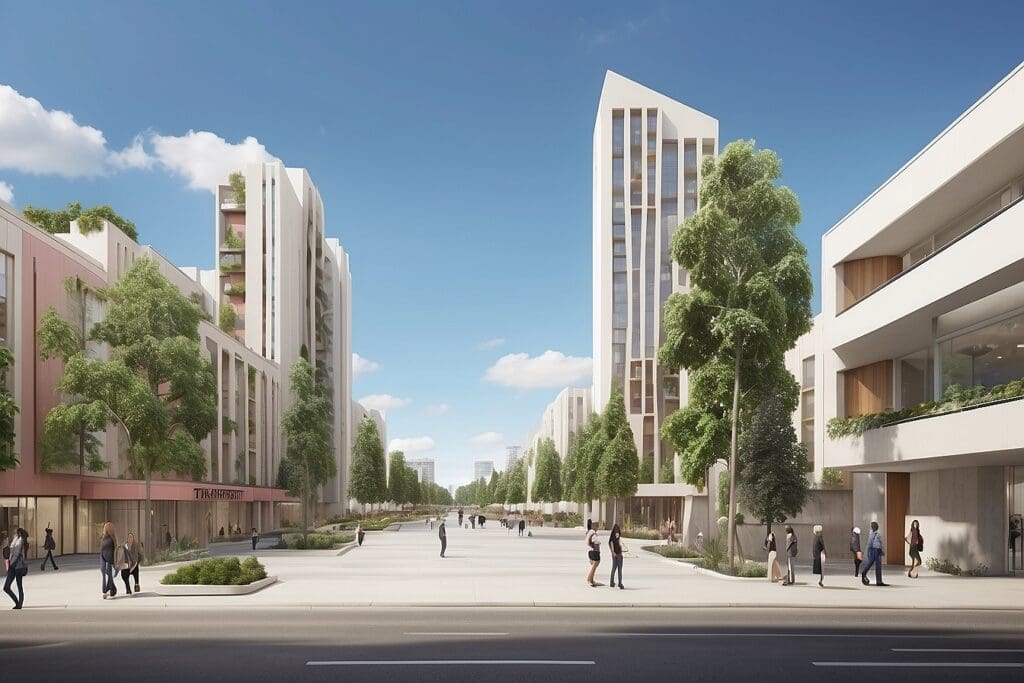The average American uses eight times as much energy as the average European per day, and yet Europeans enjoy a higher standard of living.1 A growing city planning movement called New Urbanism claims to have the solution.
What is New Urbanism? New Urbanism is a recent trend in city planning that developed in the last few decades. The basic premise of New Urban neighborhoods is a rejection of all the environmental and social consequences of suburban sprawl. While originally a solution to housing congestion in cities, sprawl is now creating many more problems of its own.2 Because of the long distance between work, home, and stores, using a car everyday is practically a necessity. Using a car means contributing to global warming, increasing traffic congestion, paving over farmland and wilderness, and depending on the volatile price of oil.3
By contrast, New Urban neighborhoods are designed around walking, bicycling, and public transportation. One way to achieve this is to make everything within walking distance of resident’s homes. This could be done with mixed-use neighborhoods, or neighborhoods where residents live above and side-by-side with stores and businesses where they shop and work.4 Another major strategy is to have New Urban neighborhoods have more walkways, bike paths, and public transportation systems. In addition to combating all the other negative effects, creating alternatives to cars allows residents to integrate exercise into their daily routine, to breathe less air pollution from cars, and to spend less of their income on cars or gasoline.5
Lastly, a central element of New Urbanism is to foster a sense of community. First, it does so by creating more public space such as boulevards, public parks, and other walking paths in which residents can encounter each other on a daily basis.6 Second, by making transportation between residential and commercial areas closer or accessible by public transportation, New Urban neighborhoods are much more economically accessible for those who cannot afford cars. Because of this, there can also be more racially and generationally diverse neighborhoods.7

On the other hand, a major impediment in converting suburban areas into New Urban areas the principle of zoning. Zoning laws dictate that residential districts and business districts must be separated from each other.8 Zoning laws were originally put in place to protect families from the more dangerous aspects of cities, such as pollution, crime, and a concentrated population.9 However, today, most cities in the United States do not contain high-pollution industrial factories, but rather, just shopping centers and office parks.10 Mixed-use New Urban areas would be medium-density,11 thus preventing many of the problems which led to zoning, in order to allow for the more efficient use of space, planning that residents would live above stores, close to where they work and go shopping.12
Want to visit some New Urban towns? There are over 600 New Urban towns in the United States. If you go to Florida, you’ll find two of the most famous New Urban towns. The very first New Urban town built was Seaside, Florida, in 1981.13 In 1995, the town of Celebration in Florida was planned and designed by the Walt Disney Company.14
However, as good as this sounds, not everyone is receptive to New Urbanism as an idea. One of the most common criticisms of New Urbanism is that it attempts to socially engineer a sense of community, rather than allow one to naturally take form. However, New Urbanists argue that this misses the point. Although they want to foster communities, the most important way to do so is through providing equal access to facilities and overcome some of the barriers to a sense of community.15
Another common criticism is that most New Urban neighborhoods that have been constructed so far have tended to be dominated by rich, white Americans rather than by a diverse group of residents. Those who work at industrial centers can no longer live in the service-oriented town, and therefore, are gentrified by the new professional class that moves into the area.16 Although the popularity and the novelty of New Urbanism does raise the price of the neighborhood, perhaps as more and more neighborhoods take on New Urban characteristics, these neighborhoods will become more and more economically accessible for everyone.
So far, New Urbanism has not become mainstream, or at least not yet. Until then, I can’t wait to see what kind of progress it can make on the way there.


